1994 PONTIAC GRAND-AM tires
[x] Cancel search: tiresPage 137 of 274
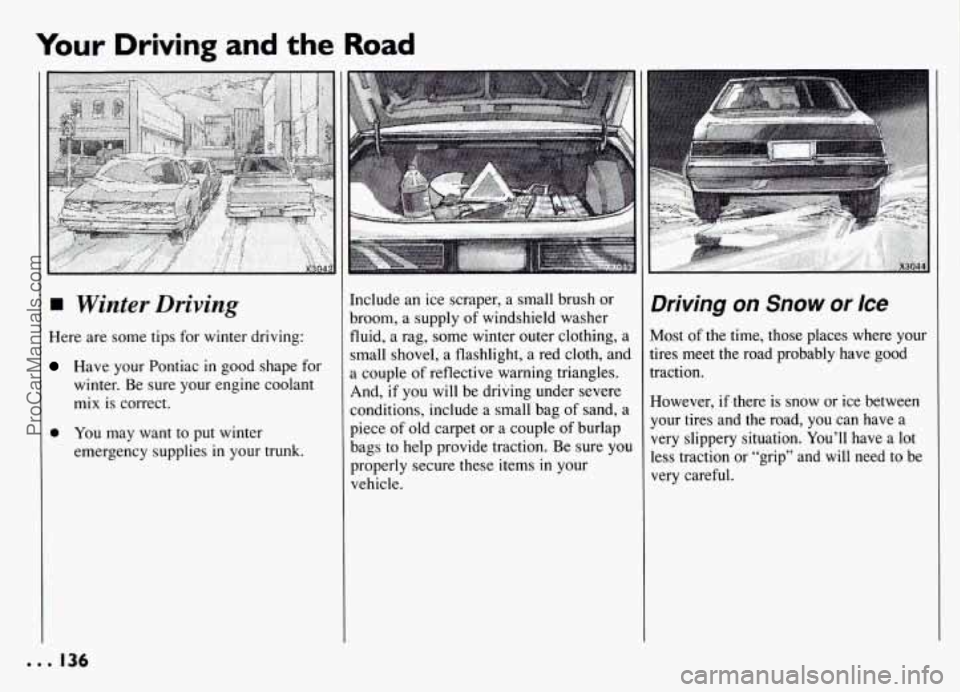
Your Driving and the Road
Winter Driving
Here are some tips for winter driving:
Have your Pontiac in good shape for
winter. Be sure your engine coolant
mix is correct.
0 You may want to put winter
emergency supplies in your trunk.
Include an ice scraper, a small brush or
broom, a supply
of windshield washer
fluid, a rag, some winter outer clothing, a
small shovel, a flashlight, a red cloth, and
a couple of reflective warning triangles.
And, if you will be driving under severe
conditions, include a small bag of sand, a
piece of old carpet or a couple
of burlap
bags
to help provide traction. Be sure you
properly secure these items
in your
vehicle.
Driving on Snow or Ice
Most of the time, those places where your
tires meet the road probably have good
traction.
However, if there is snow or ice between
your tires and the road, you can have a
very slippery situation. You’ll have a lot
less traction or “grip” and will need to be
very careful.
. . . 136
ProCarManuals.com
Page 138 of 274
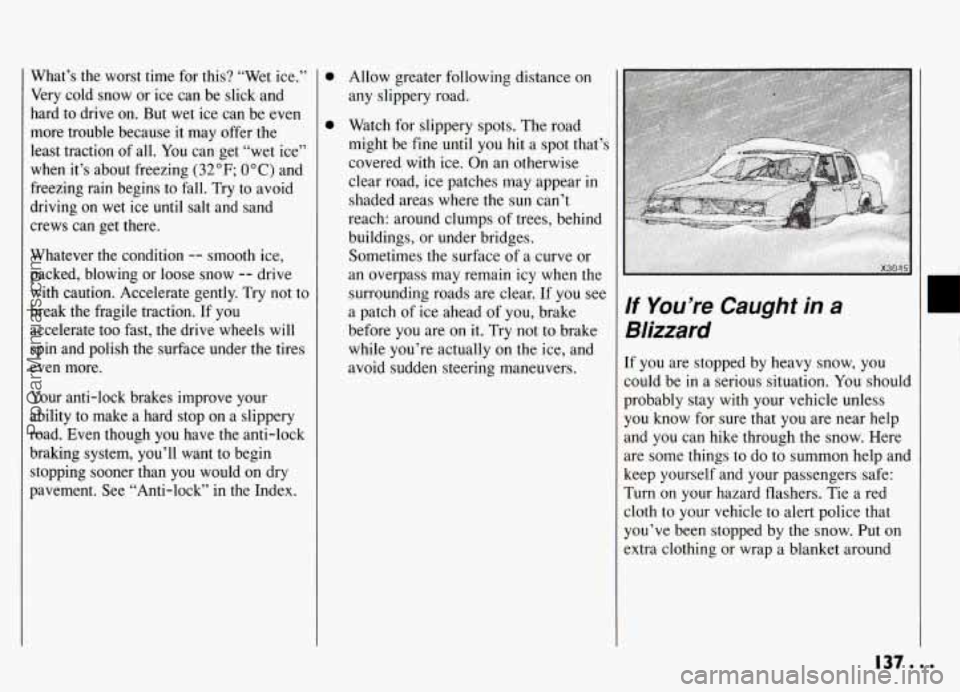
What’s the worst time for this? “Wet ice.”
Very cold snow or ice can be slick-and
hard to drive on. But wet ice can be even
more trouble because it may offer the
least traction of all. You can get “wet ice”
when it’s about freezing
(32°F; OOC) and
freezing rain begins to fall. Try to avoid
driving on wet ice until salt and sand
crews can get there.
Whatever the condition -- smooth ice,
packed, blowing or loose snow
-- drive
with caution. Accelerate gently. Try not to
break the fragile traction. If you
accelerate too fast, the drive wheels will
spin and polish the surface under the tires
even more.
Your anti-lock brakes improve your
ability to make a hard stop on a slippery
road. Even though you have the anti-lock
braking system, you’ll want to begin
stopping sooner than you would on dry
pavement. See “Anti-lock” in the Index.
0
0
Allow greater following distance on
any slippery road.
Watch for slippery spots. The road
might be fine until you hit a spot that’s
covered with ice. On an otherwise
clear road, ice patches may appear
in
shaded areas where the sun can’t
reach: around clumps of trees, behind
buildings, or under bridges.
Sometimes the surface
of a curve or
an overpass may remain icy when the
surrounding roads are clear. If you see
a patch of ice ahead of you, brake
before you are on it. Try not to brake
while you’re actually on the ice, and
avoid sudden steering maneuvers.
If You’re Caught in a
Blizzard
If you are stopped by heavy snow, you
could be
in a serious situation. You should
probably stay with your vehicle unless
you know for sure that you are near help
and you can hike through the snow. Here
are some things to do to summon help and
keep yourself and your passengers safe:
Turn on your hazard flashers. Tie a red
cloth to your vehicle to alert police that
you’ve been stopped by the snow.
Put on
extra clothing or wrap a blanket around
ProCarManuals.com
Page 142 of 274
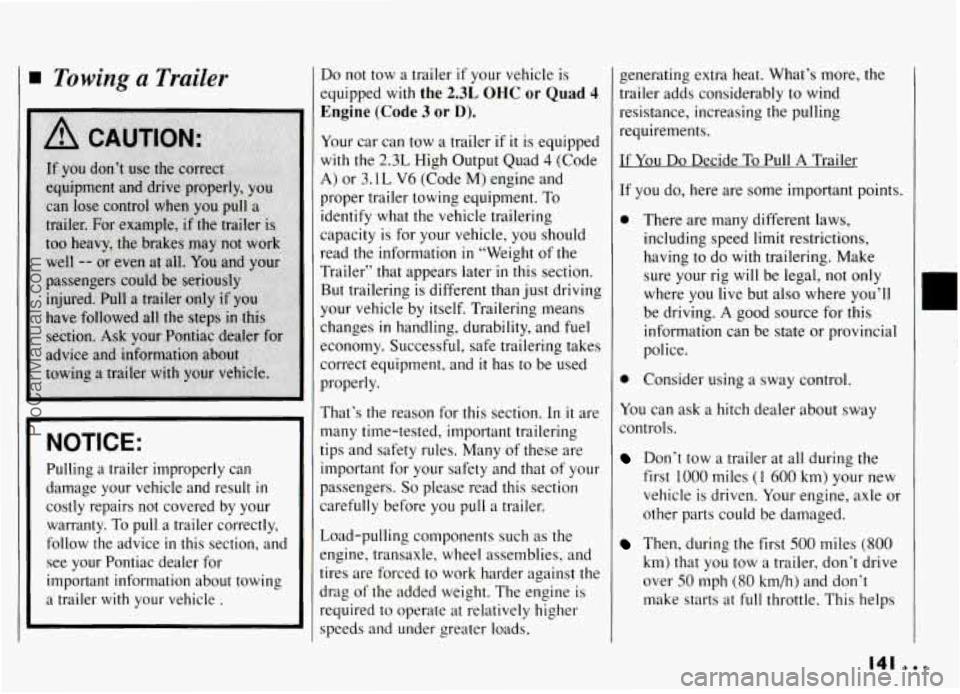
Towing a Trailer
NOTICE:
Pulling a trailer improperly can
damage your vehicle and result
in
costly repairs not covered by your
warranty. To pull
a trailer correctly,
follow the advice
in this section, and
see your Pontiac dealer for important information about towing
a trailer
with your vehicle .
Do not tow a trailer if your vehicle is
equipped with the 2.3L OHC or Quad 4
Engine (Code 3 or D).
Your car can tow a trailer if it is equipped
with the
2.3L High Output Quad 4 (Code
A) or 3.1 L V6 (Code M) engine and
proper trailer towing equipment. To
identify what the vehicle trailering
capacity is for your vehicle, you should
read the information
in ‘‘Weight of the
Trailer” that appears later
in this section.
But trailering is different than just driving
your vehicle by itself. Trailering means
changes
in handling, durability, and fuel
economy. Successful, safe trailering takes
correct equipment, and
it has to be used
properly.
That’s the reason for this section. In it are
many time-tested, important trailering
tips and safety rules. Many of these are
important for your safety and that of your
passengers.
So please read this section
carefully before you puli a trailer.
Load-pulling components such as the
mgine, transaxle, wheel assemblies, and
tires are forced
to work harder against the
jrag of the added weight. The engine is
required to operate at relatively higher
speeds and under greater loads,
generating extra heat. What’s more, the
trailer adds considerably to wind
resistance, increasing the pulling
requirements.
If You Do Decide To Pull A Trailer
If you do, here are some important points.
0 There are many different laws,
including speed limit restrictions,
having to do with trailering. Make
sure your rig will be legal, not only
where you live but also where you’ll
be driving.
A good source for this
information can be state or provincial
police.
0 Consider using a sway control.
You can ask a hitch dealer about sway
controls.
Don’t tow a trailer at all during the
first 1000 miles (1 600 km) your new
vehicle is driven. Your engine, axle or
other parts could be damaged.
Then, during the first 500 miles (800
km) that you tow a trailer, don’t drive
over
50 mph (80 km/h) and don’t
make starts
at full throttle. This helps
141
ProCarManuals.com
Page 144 of 274
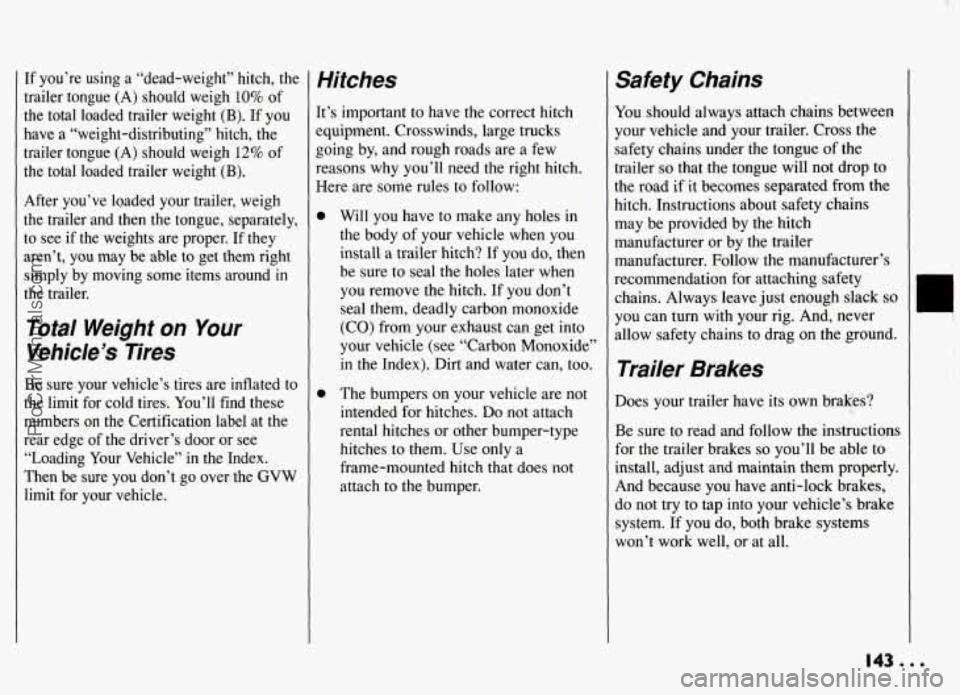
If you’re using a “dead-weight” hitch, the
trailer tongue
(A) should weigh 10% of
the total loaded trailer weight (B). If you
have
a “weight-distributing” hitch, the
trailer tongue
(A) should weigh 12% of
the total loaded trailer weight
(B).
After you’ve loaded your trailer, weigh
the trailer and then the tongue, separately, to see if the weights are proper. If they
aren’t, you may
be able to get them right
simply by moving some items around in
the trailer.
Total Weight on Your
Vehicle’s Tires
Be sure your vehicle’s tires are inflated to
the limit for cold tires. You’ll find these
numbers on the Certification label at the
rear edge of the driver’s door or see
“Loading Your Vehicle”
in the Index.
Then be sure you don’t go over the GVW
limit for your vehicle.
Hitches
It’s important to have the correct hitch
equipment. Crosswinds, large trucks
going by, and rough roads are a few
reasons
why you’ll need the right hitch.
Here are some rules to follow:
Will you have to make any holes in
the body
of your vehicle when you
install a trailer hitch? If
you do, then
be sure to seal the holes later when
you remove the hitch. If you don’t
seal them, deadly carbon monoxide
(CO) from your exhaust can get into
your vehicle (see “Carbon Monoxide”
in the Index). Dirt and water can, too.
The bumpers on your vehicle are
not
intended for hitches. Do not attach
rental hitches or other bumper-type hitches to them. Use only a
frame-mounted hitch that does not
attach to the bumper.
Sa#ety Chains
You should always attach chains between
your vehicle
and your trailer. Cross the
safety chains under the tongue of the
trailer
so that the tongue will not drop to
the road if it becomes separated from the
hitch. Instructions about safety chains may be provided by the hitch
manufacturer or by the trailer
manufacturer. Follow the manufacturer’s
recommendation for attaching safety chains. Always leave just enough slack
so
you can turn with your rig. And, never
allow safety chains to drag on the .ground.
Trailer Brakes
Does your trailer have its own brakes?
Be sure to read and follow the instructions
for the trailer brakes
so you’ll be able to
install, adjust and maintain them properly.
And because you have anti-lock brakes,
do not try to tap into your vehicle’s brake
system. If you do, both brake systems
won’t work well, or at all.
0
!
1
I I
!
143...
ProCarManuals.com
Page 145 of 274

Your Driving and the Road
I Driving with a Trailer
Towing a trailer requires a certain amount
of experience. Before setting out for the
open road, you’ll want to get to know
your rig. Acquaint yourself with the feel
of handling and braking with the added
weight
of the trailer. And always keep in
mind that the vehicle you are driving is
now a good deal longer and not nearly
so
.responsive as your vehicle is by itself.
Before you start, check the trailer hitch
and platform, safety chains, electrical
connector, lights, tires and mirror
adjustment. If the trailer has electric
brakes, start your vehicle and trailer
moving and then apply the trailer brake
controller by hand to be sure the brakes
are working. This lets you check your
electrical connection at the same time.
During your trip, check occasionally to be
sure that the load is secure, and that the
lights and any trailer brakes are still
working.
Following Distance
Stay at least twice as far behind the
vehicle ahead as you would when driving
your vehicle without a trailer. This can
help you avoid situations that require
heavy braking and sudden turns.
Passing
You’ll need more passing distance up
ahead when you’re towing a trailer. And,
because you’re a good deal longer, you’ll
need to go much farther beyond the
passed vehicle before you can return to
your lane.
Backing Up
Hold the bottom of the steering wheel
with one hand. Then, to move the trailer
to the left, just move that hand to the left.
To move the trailer to the right, move
your hand to the right. Always back up
slowly and,
if possible, have someone
guide you.
Making Turns
When you’re turning with a trailer, make
wider turns than normal. Do this
so your
railer won’t strike soft shoulders, curbs,
road signs, trees, or other objects. Avoid
ierky or sudden maneuvers. Signal well
in
3dvance.
Turn Signals When
Towing
a Trailer
When you tow a trailer, your vehicle has
to have a different turn signal flasher and
extra wiring. The green arrows on your
instrument panel will flash whenever you
signal a
turn or lane change. Properly
hooked up, the trailer lights will also
flash, telling other drivers you’re about to
turn, change lanes or stop.
When towing a trailer, the green arrows
on your instrument panel will flash for
turns even
if the bulbs on the trailer are
burned out. Thus, you may
think drivers
behind you are seeing your signal when
they are not. It’s important to check
occasionally to be sure the trailer bulbs
are still working.
. . . 144
ProCarManuals.com
Page 153 of 274
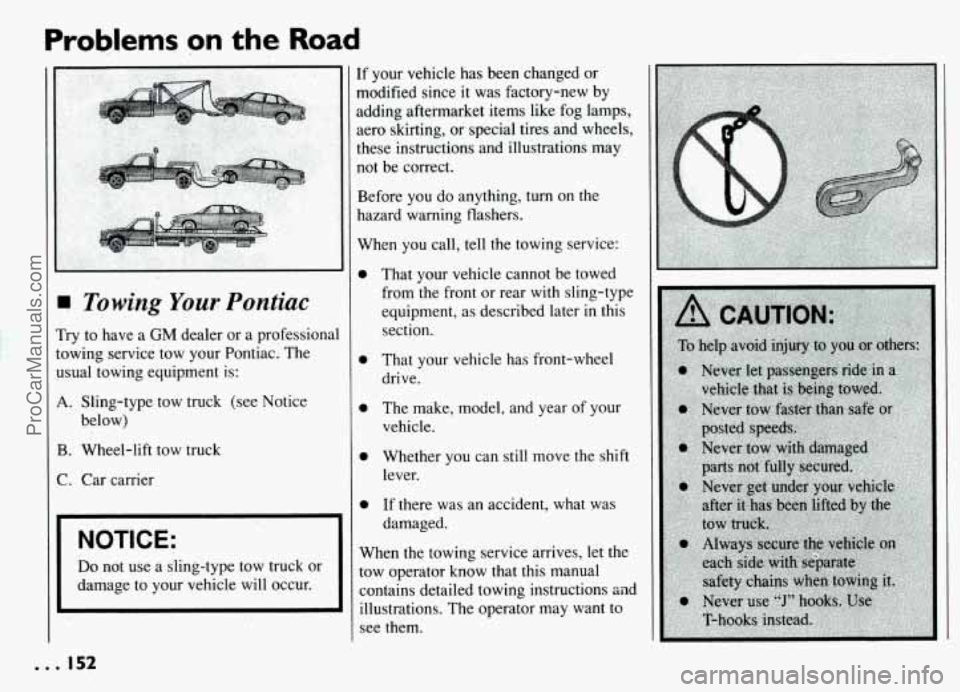
Problems .' on the .Road
3 Towing Your Pontiac
'ry to have a GM dealer or a professional
)wing service tow your Pontiac. The
sua1 towing equipment is:
L Sling-type tow truck (see Notice
below)
!. Wheel-lift tow truck
:. Car carrier
NOTICE:
Do not use a sling-type tow truck or
damage to your vehicle will occur.
If your vehicle has been changed or
modified since it was factory-new by
adding aftermarket items like fog lamps,
aero skirting, or special tires and wheels,
these instructions and illustrations may
not be correct.
Before you do anything, turn on the
hazard warning flashers.
When you call, tell the towing service:
0 That your vehicle cannot be towed
from the front or rear with sling-type
equipment, as described later in this
section.
0 That your vehicle has front-wheel
drive.
0 The make, model, and year of your
vehicle.
0 Whether you can still move the shift
lever.
0 If there was an accident, what was
damaged.
When the towing service arrives, let the
tow operator know that this manual
contains detailed towing instructions sad
illustrations: The operator may want to
see them.
ProCarManuals.com
Page 162 of 274
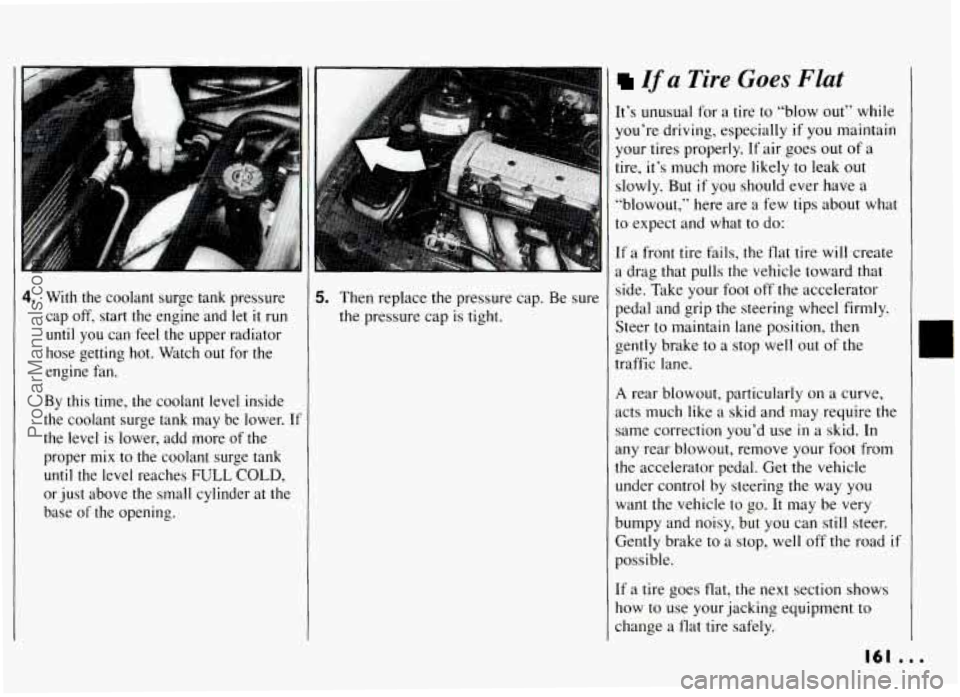
7
4. With the coolant surge tank pressure
cap off, start the engine and let
it run
until you can feel the upper radiator
hose getting hot. Watch out for the
engine fan.
By this time, the coolant level inside
the coolant surge tank may be lower. If
the level is lower, add more
of the
proper
mix to the coolant surge tank
until the level reaches FULL COLD,
or just above the small cylinder at the
base
of the opening.
I
5. Then replace the pressure cap. Be sure
the pressure cap is tight.
If a Tire Goes Flat
It’s unusual for a tire to “blow out” while
you’re driving, especially
if you maintain
your tires properly. If air goes out
of a
tire, it’s much more likely to leak out
slowly. But if you should ever have a
“blowout,” here are
a few tips about what
to expect and what to do:
If a front tire fails, the flat tire will create
a drag that pulls the vehicle toward that
side. Take your foot off the accelerator
pedal and grip
the steering wheel firmly.
Steer to maintain lane position, then
gently brake to
a stop well out of the
traffic lane.
A rear blowout, particularly on a curve,
acts much like a skid and may require
the
same correction you’d use in a skid. In
my rear blowout, remove your foot from
the accelerator pedal. Get the vehicle
under control by steering the way you
want the vehicle to go. It may be very
wmpy and noisy, but you can still steer.
Sently brake to a stop, well off the road if
Jossible.
[fa tire goes flat, the next section shows
low to use your jacking equipment to
:hange a
flat tire safely.
161 ...
ProCarManuals.com
Page 168 of 274
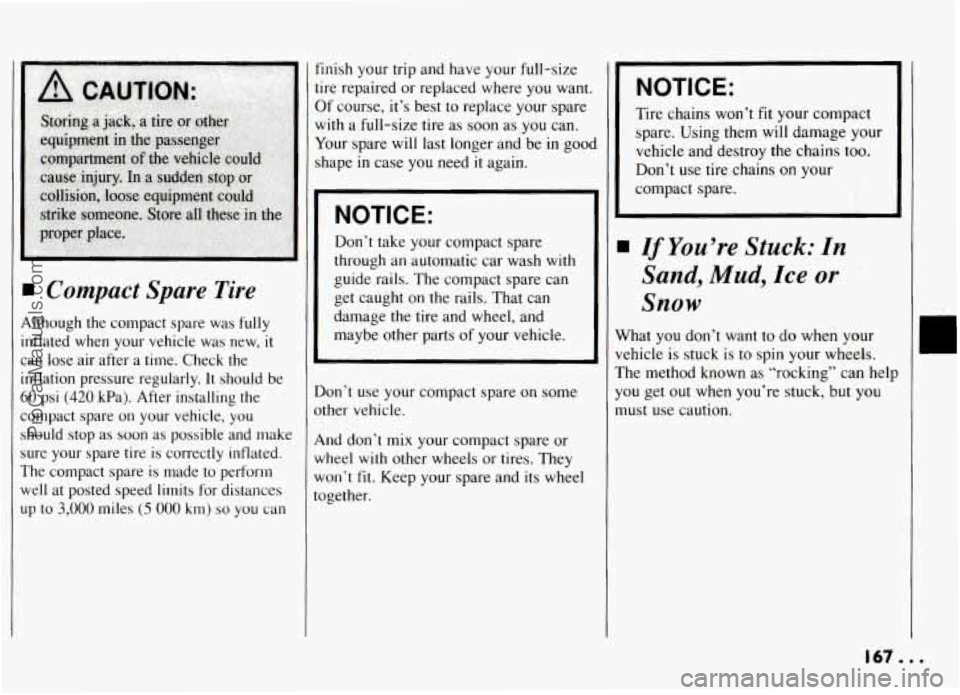
P
t
I
A
ir:
in
Ci
SL
W
I Compact Spare Tire
hhough the compact spare was fully
lflated when your vehicle was new, it
in lose air after a time. Check the
iflation pressure regularly. It should be
3 psi (420 kPa). After installing the
Impact spare on your vehicle, you lould stop as soon as possible and make
ire your spare tire is correctly inflated.
he compact spare is made to perform
ell at posted speed limits for distances
J to 3,000 miles (5 000 km) so you can
finish your trip and have your full-size
tire repaired or replaced where you want.
Of course, it’s best to replace your spare
with a full-size tire as soon as you can.
Your spare will last longer and be
in good
shape
in case you need it again.
NOTICE:
Don’t take your compact spare
through an automatic car wash
with
guide rails. The compact spare can
get caught on the rails. That can
damage the tire and wheel, and
maybe other parts of your vehicle.
Don’t use your compact spare on some
other vehicle.
And don’t mix your compact spare or
wheel
with other wheels or tires. They
won’t fit. Keep your spare and its wheel
:ogether.
NOTICE:
Tire chains won’t fit your compact
spare. Using them will damage your
vehicle and destroy the chains too.
Don’t use tire chains on your
compact spare.
If You’re Stuck: In
Sand, Mud, Ice or
Snow
Jhat you don’t want to do when your
zhicle is stuck is to spin your wheels.
The method known as “rocking” can help
you get out when you’re stuck, but you
must use caution.
167 ...
ProCarManuals.com